
When I first started learning JavaScript, I didn’t know what ajax cross-domain was, but I often heard some big guys talking about ajax cross-domain issues across domains. I must have classmates like me. , so let’s take a look today at what exactly ajax cross-domain is, and what are the methods to solve ajax cross-domain!
Preface
Regarding cross-domain, there are N types. This article only focuses on ajax request cross-domain (, ajax cross-domain only belongs to browsing Part of the "same origin policy" of the server, others include Cookie cross-domain, iframe cross-domain, LocalStorage cross-domain, etc. (not introduced here), the content is roughly as follows:
1. What Is ajax cross-domain
##Principle
Performance (sorted out some encounters problems and solutions)
2. How to solve ajax cross-domain
JSONP method
CORS method
Proxy request method
3. How to analyze ajax cross-domain
http packet capture analysis
Some examples
What is ajax cross-domain
The principle of cross-domain ajax
The main reason why ajax has a cross-domain request error problem is because of browsing For the "same origin policy" of the browser, you can refer toBrowser origin policy and its circumvention methods
CORS request principle
CORS is a W3C standard, the full name is "Cross-origin resource sharing" (Cross-origin resource sharing). It allows the browser to issue XMLHttpRequest requests to cross-origin servers, thereby overcoming the limitation that AJAX can only be used from the same origin. Basically all current browsers have implemented the CORS standard. In fact, almost all browser ajax requests are based on the CORS mechanism, but front-end developers may not care about it (so in fact The current CORS solution mainly considers how to implement the background). Regarding CORS, it is highly recommended to readDetailed explanation of CORS for cross-domain resource sharing
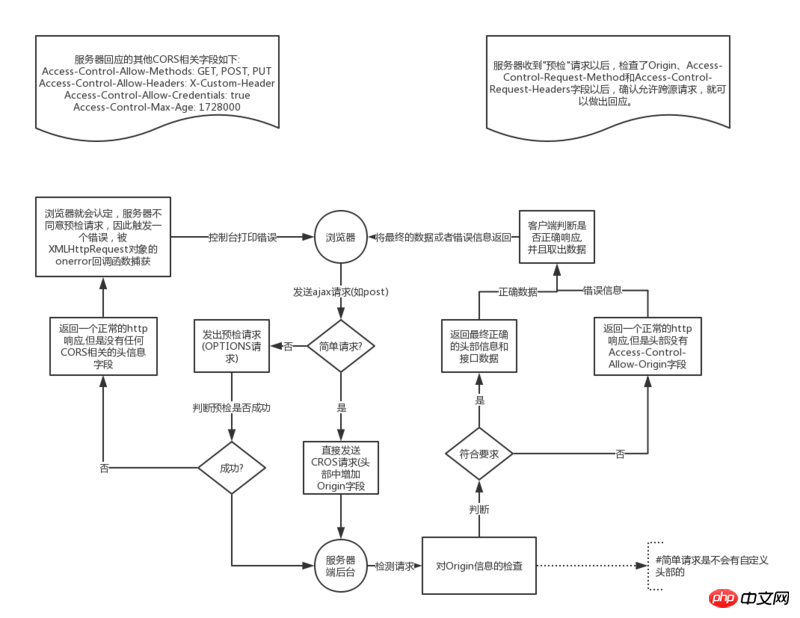
#How to determine whether it is a simple request?Browsers divide CORS requests into two categories: simple requests (simple requests) and non-so-simple requests (not-so-simple requests). As long as the following two conditions are met at the same time, it is a simple request.
1.Request method is one of the following three methods: HEAD, GET, POST
2. HTTP header information Do not exceed the following fields:1. Accept 2. Accept-Language
3. Content-Language
4. Last-Event-ID
5. Content-Type (limited to three values application/x-www-form-urlencoded, multipart/form-data, text/plain)
Whenever different If the above two conditions are met, it is a non-simple request.
Ajax cross-domain performance
To be honest, I compiled an article at first and then used it as a solution, but later I found that it was still Many people still don't know how. We have no choice but to debug it which is time-consuming and labor-intensive. However, even if I analyze it, I will only judge whether it is cross-domain based on the corresponding performance, so this is very important. When making an ajax request, if there is a cross-domain phenomenon and it is not resolved, the following behavior will occur: (Note, it is an ajax request. Please do not say why http requests are OK but ajax is not, because ajax is accompanied by Cross-domain, so just http request ok is not enough)
Note: Please see the title position for specific back-end cross-domain configuration.
The first phenomenon:No 'Access-Control-Allow-Origin' header is present on the requested resource, and The response had HTTP status code 404
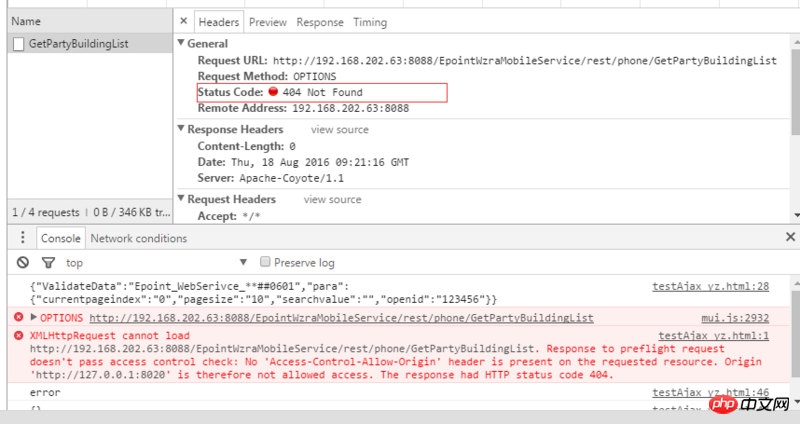
The reasons for this situation are as follows:
1. This ajax request is "Not a simple request", so a preflight request (OPTIONS) will be sent before the request
2. The server-side background interface does not allow OPTIONS requests, resulting in the inability to find the corresponding interface address
Solution: The backend allows options requests
Second phenomenon:No 'Access-Control-Allow-Origin' header is present on the requested resource, andThe response had HTTP status code 405
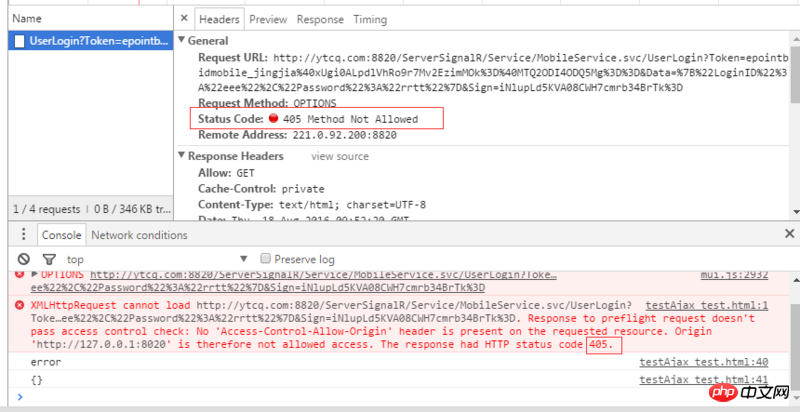
This phenomenon is different from the first one. In this case, the background method allows OPTIONS requests, but some
configuration files (such as security configuration) block OPTIONS requests, which causes this phenomenon.
Solution: Close the corresponding security configuration on the backendThe third phenomenon:No 'Access-Control-Allow-Origin' header is present on the requested resource , and status 200
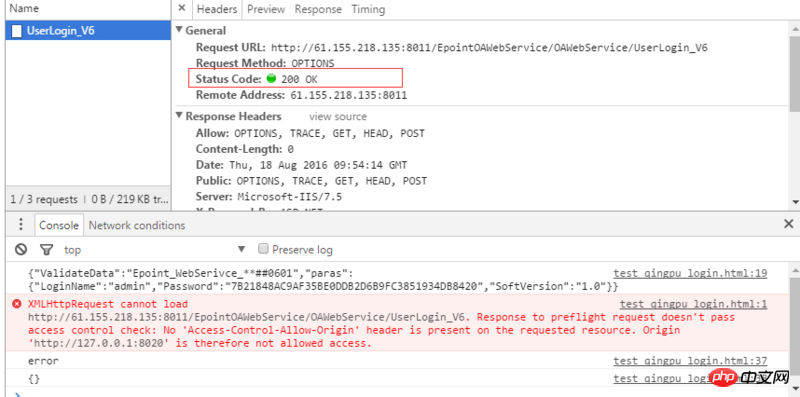
##This phenomenon is different from the first and second , In this case, the server-side background allows OPTIONS requests, and the interface also allows OPTIONS requests, but there is a mismatch when the headers match.
For example, the origin header check does not match, for example, some headers are missing. Support (such as the common X-Requested-With header), and then the server will return the response to the front-end. After the front-end detects this, it will trigger XHR.onerror, causing the front-end console to report an error
Solution: The backend adds corresponding header support
Fourth phenomenon:
heade contains multiple values '*,*'
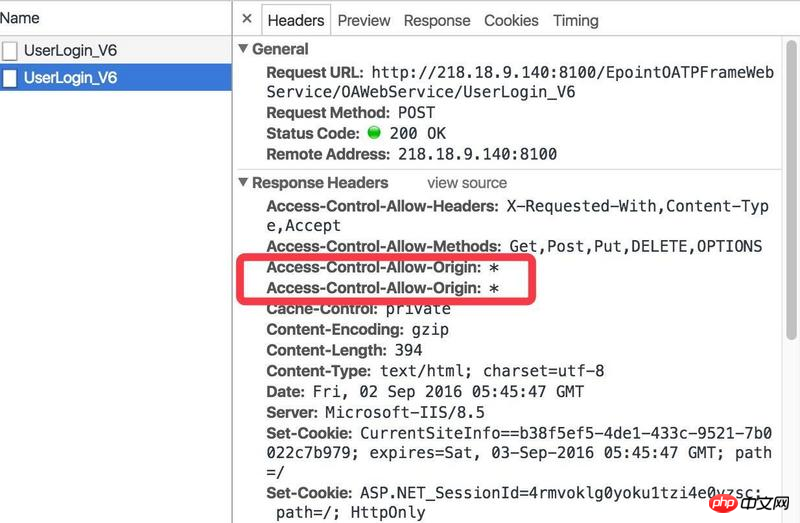
##The phenomenon is that the http header information of the background response has two Access-Control-Allow-Origin:*
To be honest, this kind of problem occurs The main reason is that people who perform cross-domain configuration do not understand the principle, resulting in repeated configurations, such as: 1. Commonly seen in the .net background (usually origin is configured once in web.config, and then again in the code Manually added an origin (for example, the code manually sets the return *)) 2. Commonly used in the .net background (set Origin:* in IIS and the project's webconfig at the same time)Solution (one-to-one correspondence):
1. It is recommended to delete the * manually added in the code and only use the ones in the project configuration 2 , it is recommended to delete the configuration under IIS*, and only use the configuration in the project configuration How to solve ajax cross-domainGeneral Ajax cross-domain solution is solved through JSONP or CORS, as follows: (Note that JSONP is almost no longer used, so just understand JSONP)
jsonp is a relatively old solution to solve cross-domain problems (not recommended in practice). Here is a brief introduction (if you want to use JSONP in actual projects, you will generally use JQ and other class libraries that encapsulate JSONP to make ajax requests)
Implementation principleThe reason why JSONP can be used to solve cross-domain problems The main reason for this solution is that <script> scripts have cross-domain capabilities, and JSONP takes advantage of this to achieve it. The specific principle is shown in the figure</script>
Implementation process
The implementation steps of JSONP are roughly as follows (refer to the article in the source)
1. The client web page requests JSON from the server by adding a <script> element Data, this approach is not restricted by the same-origin policy</script>
function addScriptTag(src) {
var script = document.createElement('script');
script.setAttribute("type","text/javascript");
script.src = src;
document.body.appendChild(script);
}
window.onload = function () {
addScriptTag('http://example.com/ip?callback=foo');
}
function foo(data) {
console.log('response data: ' + JSON.stringify(data));
};When requesting, the interface address is used as the src of the built script tag. In this way, when the script tag is built, the final src is returned by the interface Content
2. The corresponding interface on the server side adds a function wrapping layer outside the return parameter
foo({
"test": "testData"
});3. Since the script requested by the




